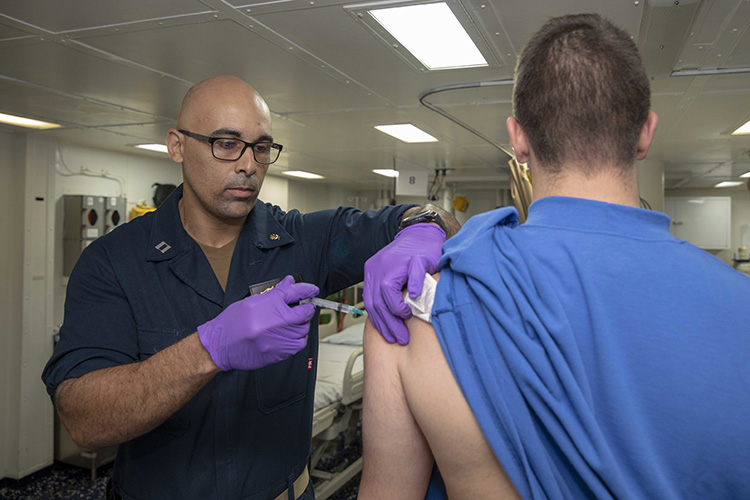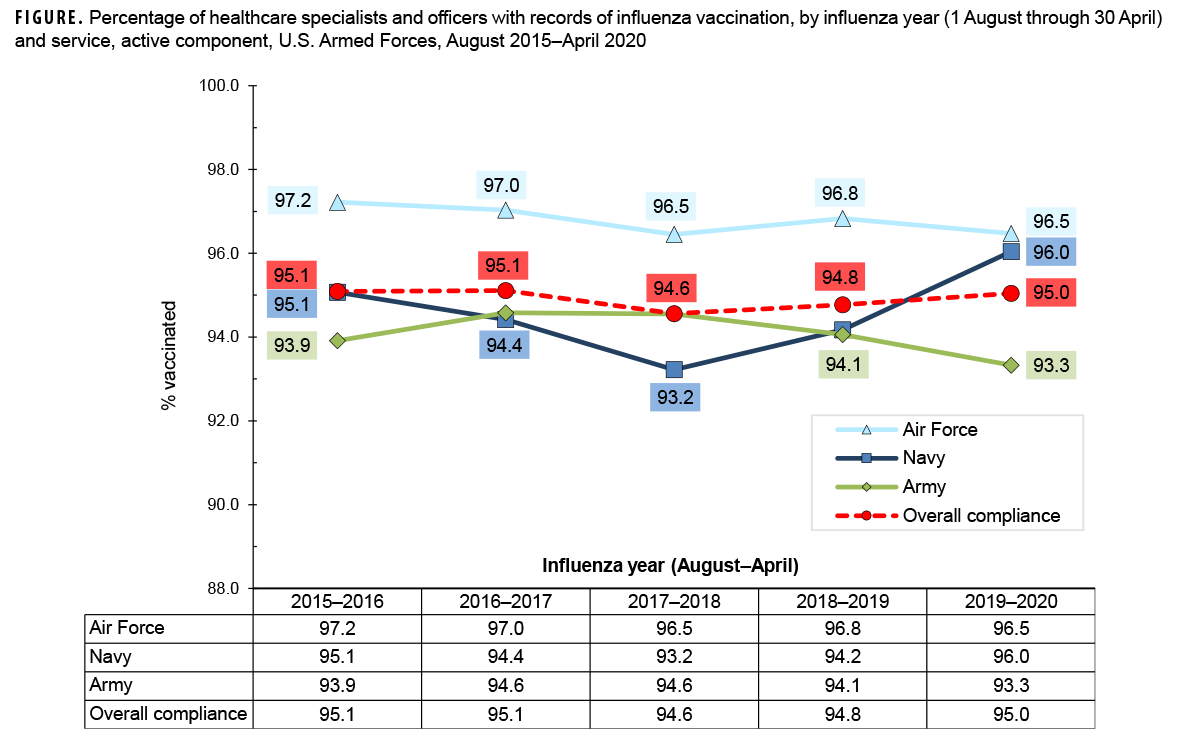Surveillance Snapshot: Influenza Immunization Among U.S. Armed Forces Healthcare Workers, August 2015–April 2020
 NORFOLK (Oct. 15, 2019) Lt. Sipriano Marte administers an influenza vaccination to Airman Tyler French in the intensive care unit aboard the Wasp-class amphibious assault ship USS Kearsarge (LHD 3). Kearsarge is underway conducting routine training. (U.S. Navy photo by Mass Communication Specialist Petty Officer 3rd Class Jacob Vermeulen/Released)
NORFOLK (Oct. 15, 2019) Lt. Sipriano Marte administers an influenza vaccination to Airman Tyler French in the intensive care unit aboard the Wasp-class amphibious assault ship USS Kearsarge (LHD 3). Kearsarge is underway conducting routine training. (U.S. Navy photo by Mass Communication Specialist Petty Officer 3rd Class Jacob Vermeulen/Released)
10/1/2020
By:
Armed Forces Health Surveillance Branch Communications Team
The U.S. Advisory Committee on Immunization Practices recommends that all healthcare personnel be vaccinated against influenza to protect themselves and their patients.1 The Joint Commission’s standard on infection control emphasizes that individuals who are your infected with influenza virus are contagious to others before any signs or symptoms appear. The Joint Commission requires that healthcare organizations have influenza vaccination programs for practitioners and staff and that they work toward the goal of 90% receipt of influenza vaccine. Within the Department of Defense, seasonal influenza immunization is mandatory for all uniformed personnel and for healthcare personnel who provide direct patient care and is recommended for all others (excluding those who are medically exempt).2–4
This snapshot covers a 5-year surveillance period (August 2015–April 2020) and presents the documented percentage compliance with the influenza immunization requirement among active component healthcare personnel of the Army, Navy, and Air Force. During the 2019–2020 influenza season, each of the 3 services had compliance rates of 93.3% or higher among healthcare personnel (Figure). For all services together, the compliance rate was 95.0%, very similar to the rate from the previous year.
References
-
Centers for Disease Control and Prevention. Immunization of health-care personnel: recommendations of the Advisory Committee on Immunization Practices (ACIP). MMWR Recomm Rep. 2011;60(RR-7):1–45.
-
Headquarters, Departments of the Army, the Navy, the Air Force, and the Coast Guard. Army Regulation 40-562, BUMEDINST 6230.15B, AFI 48-110_IP, CG COMDTINST M6230.4G. Medical Services: Immunizations and Chemoprophylaxis for the Prevention of Infectious Diseases. 7 October 2013.
-
Assistant Secretary of Defense (Health Affairs). Policy for Mandatory Seasonal Influenza Immunization for Civilian Health Care Personnel Who Provide Direct Patient Care in Department of Defense Military Treatment Facilities. Health Affairs Policy 08-005. 4 April 2008.
-
Assistant Secretary of Defense (Health Affairs). Addition of Pandemic Influenza Vaccine or Novel Influenza Vaccine to the Policy for Mandatory Seasonal Influenza Immunization for Civilian Health Care Personnel Who Provide Direct Patient Care in Department of Defense Military Treatment Facilities. Health Affairs Policy 11-010. 28 July 2011.

You also may be interested in...
Article
Jun 1, 2024
This annual summary article uses several health care burden measures to quantify the impacts in 2023 of various illnesses and injuries among members of the active component of the U.S. Armed Forces.
Report
May 1, 2024
 .PDF |
3.55 MB
.PDF |
3.55 MB
The May 2024 MSMR features a report on mortality surveillance of active duty U.S. soldiers from 2014 to 2019; followed by three related reports on respiratory investigations, surveillance and forecasting, on: an outbreak of influenza and SARS-CoV-2 at the Armed Forces of the Philippines Health Service Education and Training Center, September–October ...
Article
May 1, 2024
This retrospective analysis describes active duty U.S. Army soldiers who died from 2014 to 2019, utilizing administrative data sources to calculate mortality rates, assess trends by category of death, and identify leading causes of death within subpopulations.
Article
May 1, 2024
This report summarizes the results and lessons from the Armed Forces Health Surveillance Division Integrated Biosurveillance forecasts for the 2022-2023 respiratory illness forecasting season.
Article
May 1, 2024
This report presents the incidence of infections and genetic characteristics of influenza and SARS-CoV-2 among Military Health System beneficiaries during the 2021-2022 surveillance season.
Article
May 1, 2024
This report describes an investigation of a respiratory outbreak at the Armed Forces of the Philippines Health Service Education and Training Center by the Walter Reed Army Institute of Research-Armed Forces Research Institute of Medical Sciences and Armed Forces of the Philippines Collaborative Molecular Laboratory, demonstrating a common source ...
Article
May 1, 2024
MSMR annually publishes an update on the incidence of malaria among U.S. service members.
Article
May 1, 2024
MSMR publishes a monthly reportable medical event update for the active component and Military Health System beneficiaries.
Report
Apr 1, 2024
 .PDF |
1.52 MB
.PDF |
1.52 MB
508-compliant PDF of MSMR Vol 31 No 4 April 2024
Article
Apr 1, 2024
Since 2001, MSMR has published regular reports on the incidence of heat illness among U.S. active component service members. This annual update presents summaries of heat stroke and heat exhaustion case counts, incidence rates, and locations from 2019 through 2023.
Article
Apr 1, 2024
This report summarizes heat stroke and heat exhaustion case counts, incidence rates, and locations among U.S. active component service members from 2019 through 2023.
Article
Apr 1, 2024
This report summarizes Military Heath System (MHS) data from 2019 through 2023 on the numbers, frequency, rates, trends, demographics, geographic locations, as well as military characteristics of exertional rhabdomyolysis among U.S. active component service members.
Article
Apr 1, 2024
This report provides a monthly updatea of Reportable Medical Events documented in the Disease Reporting System internet (DRSi) by health care providers and public health officials throughout the Military Health System. Reportable Medical Events are a critical tool for monitoring, controlling, and preventing the occurrence and spread of diseases of ...
Article
Apr 1, 2024
This report summarizes Military Heath System data from 2008 through 2023 on the numbers, frequency, rates, trends, demographics, geographic locations, as well as military characteristics of exertional hyponatremia among U.S. active component service members.
Report
Mar 1, 2024
 .PDF |
1.34 MB
.PDF |
1.34 MB
The March 2024 MSMR features a comparison of 2018 estimates from the HRBS and the PHA on tobacco and nicotine use among the U.S. military active component; followed by a report on coverage of HIV PrEP among active duty service members in 2023; supplemented by a Surveillance Snapshot of HIV PrEP prescriptions in 2023 in the active component; then a ...
You are leaving Health.mil
The appearance of hyperlinks does not constitute endorsement by the Department of Defense of non-U.S. Government sites or the information, products, or services contained therein. Although the Defense Health Agency may or may not use these sites as additional distribution channels for Department of Defense information, it does not exercise editorial control over all of the information that you may find at these locations. Such links are provided consistent with the stated purpose of this website.
You are leaving Health.mil
View the external links disclaimer.
Last Updated: July 11, 2023